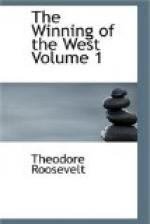“The first clergyman that came among them was the Rev. Charles Cummings, an Irishman by birth but educated in Pennsylvania. This gentleman was one of the first settlers, defended his domicile for years with his rifle in hand, and built his first meeting house on the very spot where he and two or three neighbors and one of his servants had had a severe skirmish with the Indians, in which one of his party was killed and another wounded. Here he preached to a very large and most respectable congregation for twenty or thirty years. He was a zealous whig and contributed much to kindle the patriotic fire which blazed forth among these people in the revolutionary struggle.”
This is from a MS sketch of the Holston Pioneers by the Hon. David Campbell, a son of one of the first settlers. The Campbell family, of Presbyterian Irish stock, first came to Pennsylvania, and drifted south. In the revolutionary war it produced good soldiers and commanders, such as William and Arthur Campbell. The Campbells intermarried with the Prestons, Breckenridges and other historic families, and their blood now runs in the veins of many of the noted men of the States south of the Potomac and Ohio.
4. The first settlers on the Watauga included both Virginians (as “Captain” William Bean, whose child was the first born in what is now Tennessee, Ramsey, 94) and Carolinians (Haywood, 37). But many of these Carolina hill people were, like Boon and Henderson, members of families who had drifted down from the north. The position of the Presbyterian churches in all this western hill country shows the origin of that portion of the people which gave the tone to the rest, and, as we have already seen, while some of the Presbyterians penetrated to the hills from Charleston, most came down from the north. The Presbyterian blood was, of course, Irish or Scotch, and the numerous English from the coast regions also mingled with the two former kindred stocks, and adopted their faith. The Huguenots, Hollanders, and many of the Germans being of Calvinistic creed, readily assimilated themselves to the Presbyterians. The absence of Episcopacy on the western border, while in part indicating merely the lack of religion in the backwoods, and the natural growth of dissent in such a society, also indicates that the people were not of pure English descent, and were of different stock from those east of them.
5. Campbell MSS.
6. For this settlement see especially “Civil and Political History of the State of Tennessee,” John Haywood (Knoxville, 1823), p. 37; also “Annals of Tennessee,” J. G. M. Ramsey (Charleston, 1853), p. 92, “History of Middle Tennessee,” A. W. Putnam (Nashville, 1859), p. 21, the “Address” of the Hon. John Allison to the Tennessee Press Association (Nashville, 1887); and the “History of Tennessee,” by James Phelan (Boston, 1888).
7. Now Abingdon.
8. It only went to Steep Rock.
9. November 5, 1768.




